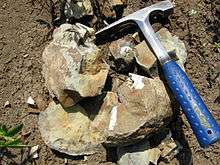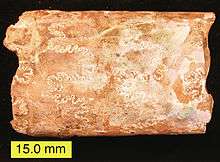Pierre Shale
The Pierre Shale /pɪər ʃeɪl/ is a geologic formation or series in the Upper Cretaceous which occurs east of the Rocky Mountains in the Great Plains, from Pembina Valley in Canada[1] to New Mexico.
The Pierre Shale was described by Meek and Hayden in 1862 in the Proceedings of the Academy of Sciences (Philadelphia). They described it as a dark-gray shale, fossiliferous, with veins and seams of gypsum, and concretions of iron oxide. The Pierre Shale is about 700 feet (210m) thick at the type locality. It overlies the Niobrara division and underlies the Fox Hills beds. It was named for an occurrence near Fort Pierre on the Missouri River in South Dakota.[2]
The Pierre Shale is of marine origin and was deposited in the Western Interior Seaway. It is correlative with other marine shales that occur farther west, such as the Bearpaw Shale, Mancos Shale and the Lewis Shale.[3] It correlates with the Lea Park Formation in central Alberta.[4] The Pierre is overlain by marginal marine deposits of the Fox Hills Formation.
Mineral resources
The Pierre Shale is the host formation for commercial oil deposits in the Florence and Canon City fields in Fremont County, Colorado, and the Boulder Oil Field in Boulder County, Colorado. More recently, natural gas has been extracted in the Raton Basin in southern Colorado. The shale formation is usually too impermeable for hydrocarbon extraction, but produces in areas where it is naturally fractured or fractured by artificial means.
Paleofauna
Hesperornithiformes
| Hesperornithiformes reported from the Pierre Shale Formation | ||||
|---|---|---|---|---|
| Genus | Species | Location | Stratigraphic position | |
|
B. varneri |
South Dakota |
Sharon Springs member.[5] | ||
|
B. sp. |
Manitoba |
Pembina member.[5] | ||
|
H. bairdi |
South Dakota |
Sharon Springs member.[5] | ||
|
H. chowi |
Manitoba & South Dakota |
Pembina, Millwood, & Sharon Springs members.[5] | ||
|
H. lumgairi |
Manitoba |
Pembina member.[5] | ||
|
H. macdonaldi |
Manitoba & South Dakota. |
Gammon, Pembina, Millwood(?), & Sharon Springs members.[5] | ||
|
H. mengeli |
Manitoba & South Dakota. |
Pembina & Sharon Springs members.[5] | ||
|
H. regalis |
Manitoba, South Dakota, & Kansas |
Gammon, Pembina, & Sharon Springs members.[5] | ||
Ornithischians
- Claosaurus affinis (hadrosaurid indet) "Pedal phalanx (lost)."[6]
Marine vertebrates
Invertebrates
- Inoceramus
- Several species of ammonites
- Several species of Baculites
References
- Canadian Fossil Discovery Centre. "All About Bruce". Archived from the original on 2014-11-06.
- M.E. Maclachlan, New Mexico Geological Society Guidebook, 27th Field Conference, Vermejo Park, 1976
- G.A. Izett and others, The Pierre Shale near Kremmling, Colorado, and its correlation to the east and the west, US Geological Survey, Professional Paper 684-A.
- Lexicon of Canadian Geologic Units. "Lea Park Formation". Archived from the original on 2013-02-21. Retrieved 2009-03-23.
- Aotsuka, K. and Sato, T. (2016). Hesperornithiformes (Aves: Ornithurae) from the Upper Cretaceous Pierre Shale, Southern Manitoba, Canada. Cretaceous Research, (advance online publication). doi:10.1016/j.cretres.2016.03.003
- "Table 20.1," in Weishampel, et al. (2004). Page 442.
- "[dinosaur] Tylosaurus saskatchewanensis (new species) + African araripemydid turtle Taquetochelys decorata". dml.cmnh.org. Retrieved 2019-02-04.

